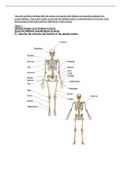You are currently working with the coach at a sports club helping run coaching sessions for
young athletes. The coach wants to provide the athletes with an understanding of how the main
body systems help them perform effectively in their sports.
Task 1:
Skeletal System and Vertebral Column
Know the different classifications of joints
P1: Describe the structure and function of the skeletal system
,
, The skeleton belonging to that of a human is often viewed by splitting it up into two separate
bone categories, these bone categories being the appendicular skeleton, and the axial skeleton.
The Appendicular, The Axial Skeleton and The Types Of Bones Within The Body
A symmetrical skeleton, forming from the development of cartilage, this category of 126 bones,
named the appendicular skeleton, includes structures such as the pelvic girdle, otherwise
known as the hip, and the shoulder girdles. The pelvic girdle includes bones such as the pubis,
the ischium and the ilium, while the shoulder girdles include the scapulae and clavicles.
The appendicular skeleton also includes the upper and lower limbs, more commonly known as
the arms and the legs. These lower limb structures (the legs and the ankles), contain bones
such as the femur, patella, tibia, fibula, tarsals and metatarsals and phalanges. Meanwhile, the
upper limb structures (arms and wrists), contain bones such as the humerus, ulnar radius,
carpals and metacarpals and phalanges.This particular skeleton, unlike the axial, enables a
large spectrum of movement for the human, due to it being unfused.
On the other hand, the axial skeleton is made up of only 80 bones, unlike the appendicular,
including structures such as the vertebral column, thorax and skull and has a number of
different functions to it’s name. There functions include supporting and protecting the organs
that are contained in the cavities, these known as the dorsal and ventral cavities, and also
allowing muscles to join to one another.




